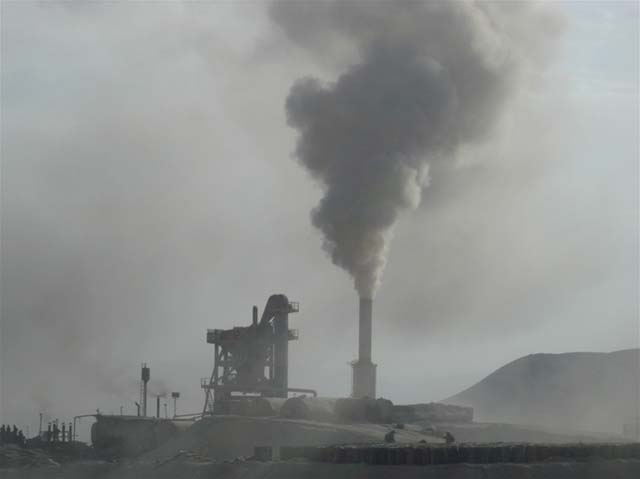Walking on Kabul streets puts one’s health at great risk. Thick columns of smoke emitting from brick kilns and factories, bumper-to-bumper vehicles producing harmful gases, malodorous garbage piled in hot weather on the sides of the roads and paths, etc. create various types of disease. Moreover, lack of sanitary facilities, water shortages and low standard of life on one hand and dense population of the city on the other hand make living highly challenging in Kabul.
The tangle of traffic that knots up downtown Kabul almost every day is one of the few hints of the invisible killer stalking the city. Tens of thousands of vehicles that choke the city’s roads are old, run on leaded gasoline and have dodgy exhaust systems. Many vehicles are drove over long unpaved roads kicking up clouds of dust. All these polluting cars are crammed into a city that is badly overcrowded.
It is said that most of the fuels used in Afghanistan do not comply with international standards and contain high levels of lead. A study carried out by the Afghan ministry of health in 2009 showed that the blood samples of 80 per cent of some 200 Kabul residents contained lead.
Population density in Kabul is high and most of the hills and mountain tops are occupied by houses that are lacking sanitation and access to clean water. During the rain and snow, the urban runoff saturated with human waste is transported down the hills to the streets below. The mix is ground by passing traffic to a very fine powder and once dry, it is airborne by the wind and moving traffic.
Similarly, sub-standard generators built from the old engines of cars, burning of plastic, old car tires, burnt engine oil, burning wood which is very oily in bathhouses, burning of coal ash in brick kilns, Public bathhouses and bakeries and many other noxious non-organic substances, are responsible for 20 to 25 per cent of the air pollution in the city of Kabul.
With the passage of years, due to population growth and the increasing number of vehicles on the road, the problem has grown more challenging, and it is believed that everybody is now susceptible to health hazards caused by air pollution. Lack of educational institutions and job opportunities, insecurity in restive provinces, etc. have forced the citizens to flock to Kabul so as to sustain life.
Environmental issues are inter-connected. No city in Afghanistan has a proper and technical management of solid waste. They are dumping waste in valleys and open fields, which is extremely dangerous not only in polluting the air, but also for underwater pollution.
For many it will not be an insurgent attack that causes you harm in Afghanistan, but more likely the air you breathe. According to the Afghan Ministry of Health, up to 3,000 citizens die each year in Kabul due to air pollution – this is highly critical. The facts are that there are also many more who suffer from severe upper and lower chest infections, including asthma, chronic bronchitis and heart disease.
Since the country was at war for the past three decades, there was no environmental protection at all. Doctors warn that unless effective mechanism is taken to tackle the crisis, Kabul faces serious problems. If air pollution keeps rising in the same way, Afghan people will encounter with a health disaster in the near future.
In December 2007, the Afghan government announced that haphazard, makeshift homes located on the hills around Kabul would be demolished so that trees and other plants could grow there. Plans were also announced to pave all roads to alleviate transportation problems and optimize urban spatial planning. While some work has been done on paving the main streets of the capital, the hilltop homes continue to stand and the waste produced by their occupants are waiting to be washed down to the streets of Kabul by spring rains.
In the same year, the World Health Organization released a report ranking Afghanistan as the lowest among non-African nations in deaths from environmental hazards.
Experts believe that war may kill thousands of civilians a year in Afghanistan, but choking air pollution in the capital Kabul is more deadly. The air pollution is a silent killer of large number of Afghan citizens and Kabul residents bear the brunt of the pollutions. Considering this fact, Afghan government has to counter pollution more seriously than terrorism. The factories, bathhouses and brick kilns must be standardized and moved outside the city.
Constitutionally, the state is obligated to adopt necessary measures to protect and improve forests as well as the living environment. Instead, politicians succumb to pressure by commercial enterprises and their promises of financial gain. The government fails to impose high taxes on the import of old cars to a handful of influential people who own automobile import businesses.
Launching a strong environmental awareness campaign will play an effective role in decreasing pollution and make people more attentive to their surroundings. Citizens should be aware of their responsibilities regarding their environments. Moreover, the government must encourage them to plant trees and prevent them from deforestations. In a nutshell, both the government and nation will have to fulfill their responsibilities regarding the environment and do their best to stop polluting it.
Home » Opinion » Air Pollution – A Critical Issue in Afghanistan
Air Pollution – A Critical Issue in Afghanistan
| Hujjatullah Zia

